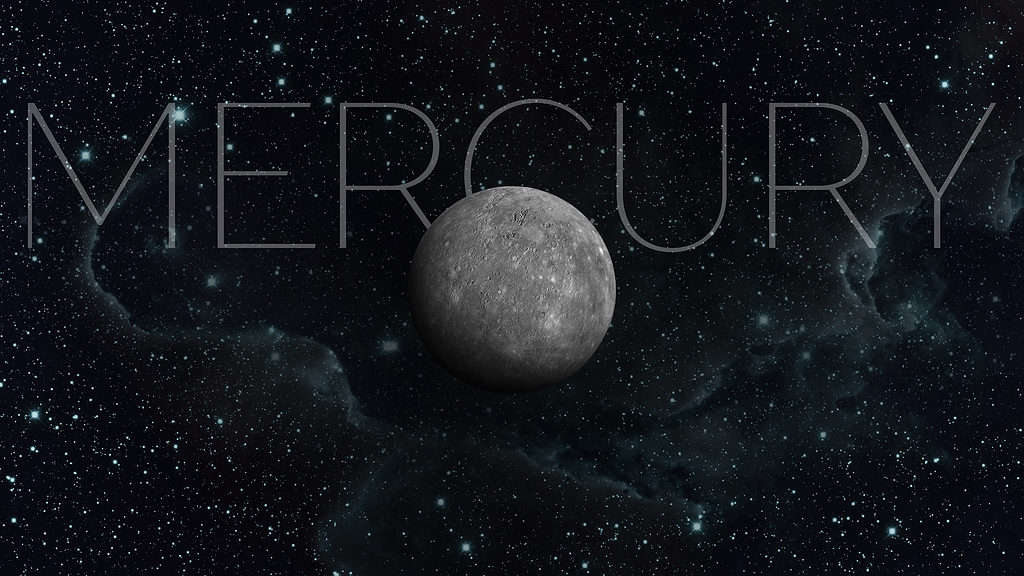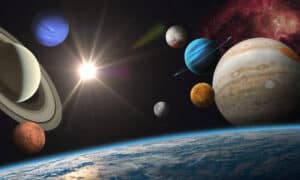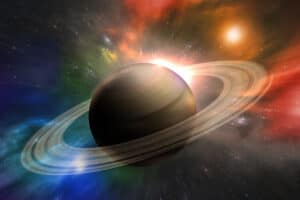Mercury is the closest planet to the Sun and one of only four rocky planets in the Solar System, along with Venus, Earth, and Mars. These planets are especially interesting to astronomers and space enthusiast. They are the closest planets to Earth and potentially some of the first sites people will try to colonize. We may also one day extract natural resources from these planets, possibly for further space exploration. Colonizing Mercury would be daunting, but not impossible. If you (or your great-grandchildren) did visit Mercury, what would it look like up close from your spacecraft? For starters, what is the color of Mercury and why does it look the way it does?

Mercury is the innermost planet in our Solar System and one of only four rocky planets.
©NASA images/Shutterstock.com
Meet Mercury
Viewed from Earth, Mercury can be seen with the naked eye as a “morning star” or “evening star” close to the Sun. It is named after a Roman god who was a messenger and a god of communication and business. The Greek equivalent god was named Hermes and wore winged sandals to speed him about his business. The planet Mercury has been known to people since ancient times, but only two spacecraft have visited it. The Mariner 10 flew past it in 1974-75 and the Messenger launched in 2004 and orbited it for four years. The European Space Agency is sending the BepiColombo spacecraft to study the planet in 2025.
Size
Mercury is 3,031.9 miles across. This distance is easy to imagine when you compare it to Earth’s Moon, which is 2,159.1 miles in diameter. Both of them are comparable to the width of the lower 48 United States, which is in the range of 2,500-3,000 miles, depending on where you measure. Mercury has no moons of its own, and like the other terrestrial planets, has no rings. Even though Mercury is smaller than Mars, it is denser, so they have about the same surface gravity. This would make it easier for astronauts to walk on its surface without bouncing as they do on the Moon.
Appearance
The color of Mercury is grey, much like our Moon. Both are made mostly of basaltic rock. Both are covered in craters but have broad flat spaces that are the result of past volcanic activity. Researchers think a mantle is under this crust, along with a solid outer core, a liquid core layer, and a solid inner core.
Craters and other geologic features on the surface are preserved for eons because the planet does not have tectonic activity. Additionally, it has only a thin atmosphere, composed of oxygen, sodium, hydrogen, helium, and potassium. This prevents craters from being weathered and eroded away as they are on Earth. Mercury does have water ice at its poles. However, the planet rotates in such a way that they are not exposed to direct sunlight and don’t evaporate. The presence of water makes it an interesting place to search for possible signs of ancient microbial life. It also seems more likely it could support human colonization.

Temperature
Mercury’s temperature, surprisingly, is not the hottest in the solar system despite the fact that it orbits closest to the sun. The hottest surface temperature of any of our planets is on Venus, where an out-of-control greenhouse effect makes it a constant seething 900°F!
Mercury gets about 4.5-10.5 more sunlight than Earth. And the Sun looks three times larger from Mercury than it does to us. Surface temperatures reach 800°F at Mercury’s equator but plunge to -280°F at night. At Mercury’s dark poles, the temperature is perpetually frozen.

Can We Colonize Mercury?
Space colonization is becoming more and more of a reality as private companies have gotten into the space flight business. Competition between them may accelerate the research, development, and investment needed if such an expensive undertaking is to be tried. The Moon and Mars are the most frequently mentioned colonization candidates, but Mercury also has some advantages. In fact, it might be the best choice of all.
Why Colonize Mercury?
Because Mercury is so close to the Sun and has no clouds, it can be an excellent source of solar energy that might be stored in batteries or beamed to other locations using yet-to-be-developed technology. It might also be a good place to build and launch “solar sail” spacecraft that could be pushed by the solar wind to great speeds for voyages beyond our solar system. Such craft might also be used to move materials manufactured on Mercury to neighboring Venus to terraform it.

Where is the Best Place to Live on Mercury?
Because the axis of Mercury is not tilted, its poles are in permanent darkness. They have water and hydrocarbons that are trapped in freezing temperatures and not boiled off by sunlight. This could make farming possible on Mercury in areas around the poles at the border between light and darkness. As a result, the poles are the most likely place for future human colonization.
Colonists could also choose to live underground where the temperature could be kept more constant and they could be shielded from radiation. It is thought that Mercury might have lava tubes like we do on Earth where people could live without having to do extensive new excavation. In fact, some researchers say that in a ring near the poles, at a depth of less than a meter, the environment is constant room temperature. Its gravity is comparable to Mars, so it would be more comfortable for colonists than the light gravity of the Moon. And its small orbit, inside Earth’s orbit, gives us many more launch windows to reach Mercury than the more limited options we have for Mars and the giant planets. For all these reasons, Mercury might even be a better candidate for a human colony than the Moon or Mars.
Who knows, maybe one day your grandchildren will invite you to come visit them on Mercury? What do you think? Would you like to go, or keep your feet firmly here on Earth?
The photo featured at the top of this post is © iStock.com/FlashMyPixel
Thank you for reading! Have some feedback for us? Contact the AZ Animals editorial team.






